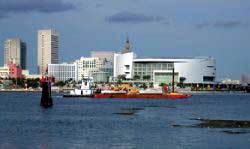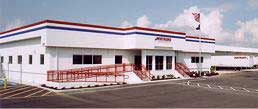FLORIDA SPOTLIGHT
DTCC: 'Ideal Location' in Tampa
Savarese and his team knew that Tampa offered a vibrant
job market, but they still did their research before they placed their
first call to the City of Tampa.
Using a complicated matrix of 40 broad site selection categories to compare locations across the Southeast, the search eventually led DTCC to consider Atlanta, Jacksonville and Tampa.
On the local side, Florida Gov. Jeb Bush, former Gov. and former Tampa Mayor Bob
Martinez and current Tampa Mayor Pam Iorio all became personally involved
in the recruitment of the firm.
DTCC employed the services of consultants who knew the Southeast well: Cushman & Wakefield Real Estate Advisory Services and Partners National Real Estate Group (PNREG) in Dallas.
"Our site selection consultants helped us evaluate several criteria -- enterprise talent, quality-of-life issues in all of the different cities, how easy it would be to market the location to our existing staff, and the economic outlook for each of the MSAs," Savarese says.
"We did our own modeling," he adds. "When we grouped the 40 categories of data, the highest weighting went to the cost of doing business -- including compensation and benefits for the employees; legal and regulatory requirements; Securities and Exchange Commission impact; quality of the local work force; availability of the work force in financial services; levels of education; business continuity; the support we thought we would get from the local office of FEMA [Federal Emergency Management Agency]; the terrorism profile of each region; and the likelihood of relocating our own employees."
Once DTCC narrowed the search to three cities, "we brought real estate into the mix," says Savarese.
PNREG analyzed each location according to the matrix and pinpointed the optimum sites for doing business. Michael Rareshide, executive vice president of PNREG, led this effort along with his colleague, senior vice president Kirk Killian.
"Our firm did all of the research on all of the real estate opportunities in each city," Rareshide says. "We took the client through all of the alternative sites, the RFP process, negotiating the deal, and all the way through to the purchase document."
Several factors drove the real estate decision-making process at the local level. Chief among them, says Rareshide, was the need for a highly secure building in a safe location.
"DTCC had certain criteria for the property. They did not want to be in a downtown, multi-tenant building. That did not work for a very security-conscious company like DTCC," Rareshide says. "So we looked at all of the major suburban markets in each city."
In Atlanta, that included Alpharetta, Gwinnett County, Buckhead and other sites outside the city. In Tampa, the search led Rareshide and his team to consider sites as far away as Clearwater, Lakeland and even the massive Lakewood Ranch development in Manatee and Sarasota counties.
Security, including the infrastructure that would provide it, made one location stand out in the Tampa Bay Area, the consultant says. That facility was the former Intermedia campus in Highwoods Preserve in New Tampa, 15 minutes northeast of downtown.
"When we looked at all of the specific real estate site selection criteria, there were several dominant factors that brought Highwoods Preserve to the top of the list," Rareshide says. "It had full security. The infrastructure was already in place. There was the availability of affordable housing. There was adequate potential for future expansion. And the overall economics of the project just made sense."
The final deal involved DTCC purchasing the 176,014-sq.-ft. (16,352-sq.-m.) Building III at Highwoods Preserve for $18 million plus an additional 3.3-acre (1.3-hectare) tract in the park for $1.5 million. Stephen Meyers, vice president of Highwoods Properties' Tampa office, says the deal worked for DTCC executives because "what they do fits that classic definition of mission critical. We competed with build-to-suit and we won the project because we provided a much higher-quality building."
The transaction includes an energy plant, including emergency generators and switch gear.
"There is a lot of redundancy built into this complex," Meyers says. "With the centrifugal chillers, there is always at least one chiller available for backup. The same is true for the cooling tower. Plus, there are three 2.2-megawatt diesel generators with fuel storage above ground to supply 72 hours of power."
The telecommunications infrastructure includes a SONET ring within a SONET ring supplied by MCI, with fiber also being supplied by Verizon.
The location also makes sense for DTCC's unique industry. By locating in Tampa, the company joins an expanding financial services cluster that includes Citigroup, J.P. Morgan Chase, Capital One, MetLife and Progressive Insurance.
"We have more than 100,000 jobs in business and financial services in Hillsborough County," says Meyers.
Most of these jobs pay much better than the average Florida salary. At DTCC, the average wage will be $72,000 a year, says Robin Ronne, senior vice president of economic development at the Greater Tampa Chamber of Commerce Committee of One Hundred.
This cluster is likely to grow in the Bay Area, particularly as more companies follow the recommendations made by the federal white paper on near-shoring mission-critical operations of financial services in the wake of Sept. 11. Those recommendations are apparently being followed by the New York Stock Exchange -- one of the sites targeted for a terror alert in August 2004 -- which recently notified its members that, as of early August, they needed to have in place business continuity and contingency plans.
Using a complicated matrix of 40 broad site selection categories to compare locations across the Southeast, the search eventually led DTCC to consider Atlanta, Jacksonville and Tampa.
On the local side, Florida Gov. Jeb Bush, former Gov. and former Tampa Mayor Bob
 |
| Miami's role as a nexus of international trade and culture received another accolade in July 2004 when Korea's Mobis Parts America, a Hyundai subsidiary, established its Latin American headquarters in the city. |
DTCC employed the services of consultants who knew the Southeast well: Cushman & Wakefield Real Estate Advisory Services and Partners National Real Estate Group (PNREG) in Dallas.
"Our site selection consultants helped us evaluate several criteria -- enterprise talent, quality-of-life issues in all of the different cities, how easy it would be to market the location to our existing staff, and the economic outlook for each of the MSAs," Savarese says.
"We did our own modeling," he adds. "When we grouped the 40 categories of data, the highest weighting went to the cost of doing business -- including compensation and benefits for the employees; legal and regulatory requirements; Securities and Exchange Commission impact; quality of the local work force; availability of the work force in financial services; levels of education; business continuity; the support we thought we would get from the local office of FEMA [Federal Emergency Management Agency]; the terrorism profile of each region; and the likelihood of relocating our own employees."
Once DTCC narrowed the search to three cities, "we brought real estate into the mix," says Savarese.
PNREG analyzed each location according to the matrix and pinpointed the optimum sites for doing business. Michael Rareshide, executive vice president of PNREG, led this effort along with his colleague, senior vice president Kirk Killian.
"Our firm did all of the research on all of the real estate opportunities in each city," Rareshide says. "We took the client through all of the alternative sites, the RFP process, negotiating the deal, and all the way through to the purchase document."
Several factors drove the real estate decision-making process at the local level. Chief among them, says Rareshide, was the need for a highly secure building in a safe location.
"DTCC had certain criteria for the property. They did not want to be in a downtown, multi-tenant building. That did not work for a very security-conscious company like DTCC," Rareshide says. "So we looked at all of the major suburban markets in each city."
In Atlanta, that included Alpharetta, Gwinnett County, Buckhead and other sites outside the city. In Tampa, the search led Rareshide and his team to consider sites as far away as Clearwater, Lakeland and even the massive Lakewood Ranch development in Manatee and Sarasota counties.
 |
| The late 2003 completion of this 98,044-sq.-ft. (9,108-sq.-m.) cross-dock facility for Watkins Motor Lines in Airport International Park in Orlando prompted park officials to finish out most of the park's infrastructure needs. |
Security, including the infrastructure that would provide it, made one location stand out in the Tampa Bay Area, the consultant says. That facility was the former Intermedia campus in Highwoods Preserve in New Tampa, 15 minutes northeast of downtown.
"When we looked at all of the specific real estate site selection criteria, there were several dominant factors that brought Highwoods Preserve to the top of the list," Rareshide says. "It had full security. The infrastructure was already in place. There was the availability of affordable housing. There was adequate potential for future expansion. And the overall economics of the project just made sense."
The final deal involved DTCC purchasing the 176,014-sq.-ft. (16,352-sq.-m.) Building III at Highwoods Preserve for $18 million plus an additional 3.3-acre (1.3-hectare) tract in the park for $1.5 million. Stephen Meyers, vice president of Highwoods Properties' Tampa office, says the deal worked for DTCC executives because "what they do fits that classic definition of mission critical. We competed with build-to-suit and we won the project because we provided a much higher-quality building."
The transaction includes an energy plant, including emergency generators and switch gear.
"There is a lot of redundancy built into this complex," Meyers says. "With the centrifugal chillers, there is always at least one chiller available for backup. The same is true for the cooling tower. Plus, there are three 2.2-megawatt diesel generators with fuel storage above ground to supply 72 hours of power."
The telecommunications infrastructure includes a SONET ring within a SONET ring supplied by MCI, with fiber also being supplied by Verizon.
The location also makes sense for DTCC's unique industry. By locating in Tampa, the company joins an expanding financial services cluster that includes Citigroup, J.P. Morgan Chase, Capital One, MetLife and Progressive Insurance.
"We have more than 100,000 jobs in business and financial services in Hillsborough County," says Meyers.
Most of these jobs pay much better than the average Florida salary. At DTCC, the average wage will be $72,000 a year, says Robin Ronne, senior vice president of economic development at the Greater Tampa Chamber of Commerce Committee of One Hundred.
This cluster is likely to grow in the Bay Area, particularly as more companies follow the recommendations made by the federal white paper on near-shoring mission-critical operations of financial services in the wake of Sept. 11. Those recommendations are apparently being followed by the New York Stock Exchange -- one of the sites targeted for a terror alert in August 2004 -- which recently notified its members that, as of early August, they needed to have in place business continuity and contingency plans.

